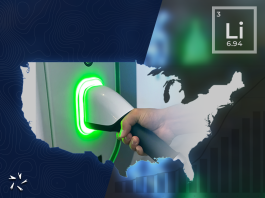John Riesenberg, Managing Director at Stardust Power, details the exciting development progress at the company’s lithium refinery project in Oklahoma.
Stardust Power’s mission is to onshore critical material manufacturing to transform the United States’ battery metals landscape. The company is developing an advanced, large-scale lithium refinery that will help to secure American energy leadership for the next generation.
Located on a 66-acre site in Muskogee, Oklahoma, the lithium refinery will process up to 50,000 metric tons of lithium once fully operational – enough to power approximately five million electric vehicle batteries per year.
We spoke to Managing Director John Riesenberg to learn more about the significance of Muskogee for housing the site and recent updates on the project’s development.
Why did Stardust Power choose Port Muskogee in Oklahoma as a location for the refinery?
Roshan Pujari, Founder and CEO of Stardust Power, is a native of Oklahoma, where he grew up. He knew with a central hub and spoke model that Stardust Power would need to be centrally located in the United States to be easily accessible to feedstock from around the US as well as offtake. A lot of people don’t know this about Muskogee, but it is connected to the largest inland waterway system in the United States. Muskogee has a port which will allow us to ship to a very large radius, anywhere that’s connected to the Mississippi River. In addition to the Port, there’s a strong rail and highway network located close to the I-40 highway.
Muskogee is part of the Tulsa Metropolitan area which provides access to a skilled labour force. The state’s incentives and enthusiasm to work with Stardust Power further confirmed our decision. Oklahoma is extremely business-friendly and the regulatory bodies are mandated to support businesses. This helps to ensure things are done within legal and environmental standards. We have excellent support from the Oklahoma Department of Environmental Quality and the Department of Commerce, among others, which has helped us navigate incentives and other requirements. The local community has also been very welcoming and supportive, making Muskogee an ideal location for the lithium refinery.
At a recent Chamber of Commerce event, Stardust Power delivered a presentation where we introduced the company and were available to meet people from the event. A line of people emerged comprised of people not only asking questions about the project but also to thank us for choosing Muskogee. Thank us for choosing their town. They’re extremely supportive, and for that, we are grateful.
Our Head Engineer, Mike Circelli, and our Director of Construction, Randall Harris, contend it is one of the best sites that they have ever seen. These guys have decades of experience, and they love everything about it. As Oklahomans, we knew the value of what he had in terms of people, location, and support. It’s great to witness the rest of the world seeing it, too.
How do you plan to staff the lithium refinery? Where will the workforce be drawn from?
At Stardust Power, we have been proactive in workforce development. For example, we are working with the Indian Capital Technology Centre, a local technology school, and universities such as Oklahoma State University. They have demonstrated they are aligning their programmes with the employment opportunities our business creates.
We’re also engaging with America Works in Muskogee to provide jobs for workers. We are even engaging with local high schools to start the process in education. Through the Port of Muskogee, Stardust Power and other manufacturers in the area have funded scholarships for individuals interested in manufacturing, further supporting workforce development.
How will Stardust Power involve the community in the operations, and how will it benefit from the project?
We are heavily invested in the community. We consider many local firms that meet our needs for construction, staffing, or supplies and meet our rigorous due diligence protocols.
We work with a number of local organisations, including the Oklahoma Business Roundtable, Select Oklahoma and the Oklahoma Manufacturing Alliance, to identify and reach out to local companies. We are also engaged with community organisations like the Muskogee Chamber of Commerce and the Greater Muskogee Manufacturing Alliance. Groups that help us integrate into the community are essential.
We have also engaged the local Cherokee and Muskogee tribal nations, both of which have strong developed workforce programmes for their tribal citizens.
You’ve also had a positive reaction from the Oklahoma Governor. How important is that for the project?
It’s been very helpful the depth that the Governor and the state have strongly supported Stardust Power. People typically think of Oklahoma only as a traditional oil and gas state, which has strong oil and gas resources and a strong oil and gas workforce. There is a legacy workforce that we can help tap into for our lithium refinery. Oklahoma Governor Kevin Stitt likes to use a famous Wayne Gretzky quote: “You don’t skate to where the puck is; you skate to where the puck is going.” That is his strategy for looking at critical minerals infrastructure and trying to position Oklahoma to bring in a lot of those new jobs for the future energy economy. The office has been extremely supportive. He gave us a reference and mentioned us in his State of the State Address in January 2024. It was an honour to be there and see him mention our company in front of the entire State of Oklahoma.
Please could you explain what incentive packages you have applied for to build out the lithium refinery?
State incentives for Stardust Power are primarily performance-based and depend on two main factors. First, there’s an investment tax credit, typically 1% for five years. However, since we are building in an enterprise zone, which is a lower-income area, we can increase that to 2% for five years.
Additionally, Oklahoma has a Quality Jobs program, which offers a 5% rebate on jobs created if we meet certain thresholds and maintain wages above 110% of the county average. These are the main incentives. There are also other state programmes, such as a sales tax exemption on energy and manufacturing equipment. We are combining these with other federal grants and programmes we’ve applied for.
Oklahoma is traditionally an oil and gas state. What has the public opinion been with it transitioning to a large-scale lithium refiner?
The public has been extremely supportive. It helps that we’re working with oil and gas companies to potentially take their wastewater and turn it into a revenue stream for them. They have been nothing but supportive. In select produced water, there are high enough concentrations of lithium that we can use as a feedstock for our lithium refinery. We are helping reduce waste and creating value where previously there wasn’t, which I think helps a lot.
Oklahoma is a pro-business state. They’re supportive of Stardust Power and creating new jobs, with their primary goal being to make sure that they can take care of their families, which we are enabling in both a safe and environmentally sustainable way.
For example, our battery grade lithium production lines are designed to have low emissions and tap into the Oklahoma electric grid which contains a robust mix of renewable energy sources.
An innovative solution we’re employing is a zero liquid discharge system, which essentially takes all the water that’s running through the plant and circulates it through a closed-loop system. It recycles the water so that we’re not discharging any wastewater into the sewage system. When it leaves the plant, it leaves as evaporated steam – it’s a very clean facility.
Have there been any concerns, and how has Stardust Power gone about engaging with the community to alleviate them?
Lithium manufacturing is newer in America, but it’s not an unproven technology. It is new to the Oklahoma area, however. We often help to engage with the community through the Port. Recently, I attended the Muskogee Fair and held a brief town hall talk without encountering any concerns. I’ve been in the community, talking to people and connecting with local businesses.
We had one individual call with some questions. I called him back, and after a conversation, he became excited about our project after learning more and understanding further. We are planning to host additional listening sessions and extend our outreach beyond Muskogee to nearby areas. We aim to address concerns proactively and explore how we can support those communities.
We have been involved with the Muskogee Chamber of Commerce, speaking at various events and sharing information and our plans for the future. The reaction has been positive, but we are not slowing down. We will stay engaged, keep talking and listening to people, and participate in different community groups, such as the tribes, the Chamber of Commerce, the Manufacturing Alliance, and the United Way. This approach will help us stay connected with the community and understand their needs.









